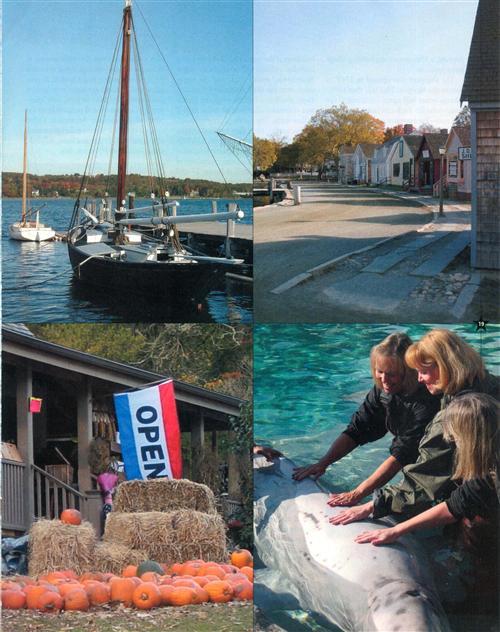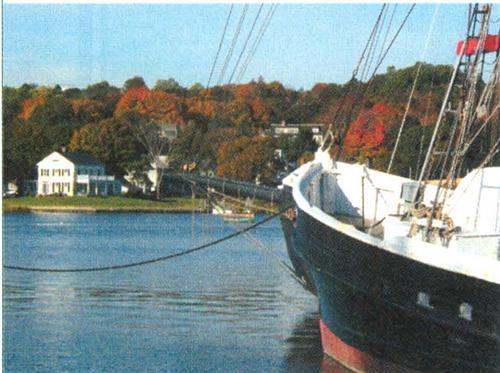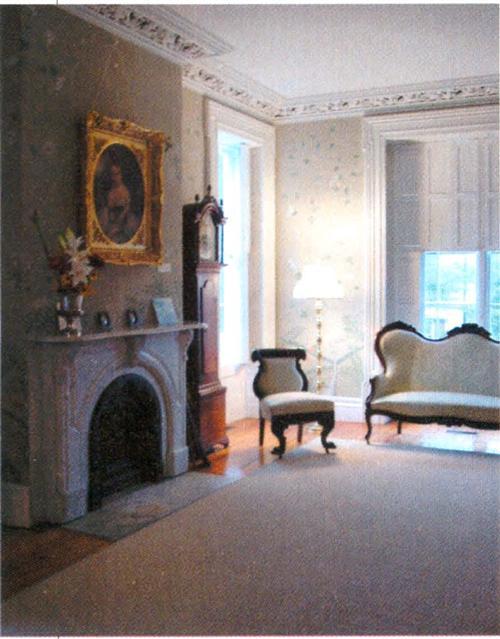Sign up for the Family Tree Newsletter Plus, you’ll receive our 10 Essential Genealogy Research Forms PDF as a special thank you!
Get Your Free Genealogy Forms
"*" indicates required fields

Barely more than 150 years after Melville wrote about the noble-yet-melancholy Pequod, only one ship remains of New England’s once-vast whaling fleet. In 1941, the fledgling Marine Historical Association, forerunner of today’s Mystic Seaport, rescued the Charles W. Morgan and brought it to Mystic, Conn., where the ship became the centerpiece of “the Museum of America and the Sea.” Period buildings from across New England joined the Morgan on the banks of the Mystic River to re-create a 19th-century whaling village. The 133-foot Morgan — the last surviving wooden, square-rigged commercial vessel from America’s great age of sail — is now one of four National Historic Landmark ships at Mystic Seaport, along with the Emma C. Berry, Sabino and L.A. Dunton. They are part of the largest collection of boats and ships in the world, totaling nearly 500.
Many of those vessels started their voyages in Mystic — between 1784 and 1919, more than 600 ships were built in this small Connecticut town. Few cities this small can match Mystic’s shipbuilding heritage, and none can compare with how that history has been preserved — and brought back to life. Some 100 interpreters make Mystic Seaport hum with activity, as it did in the 19th century — climbing riggings, singing sea chanteys, splitting codfish for salting, spinning tales of sailing adventures.
The past clings to this whole area, in fact, like the morning fog off the ocean. From the country’s oldest steam-powered cider mill to an elaborate new museum of the Indian tribe that gave the Pequod its name (see box, page 20), from an 1840 lighthouse to winding streets lined with antiques shops, Mystic and its neighboring communities seem to bend to yesteryear the way the sails of clipper ships once blossomed with the wind.
Down to the sea in ships
At the heart of this historic area is Mystic Seaport (888-973-2767, < www.mysticseaport.org>; admission $17 adults, $9 ages 6 to 12, free ages 5 and younger). Sprawling over 40 acres, with a 17-acre public exhibition area, this nonprofit attraction combines a preservation shipyard, a 19th-century shipbuilding village and a museum.
The shipyard was opened in 1969 to restore the Morgan. This fall, that 1841-vintage vessel will again come out of the water — the lift dock can raise more than 300 tons — for extensive repairs. New ships are built here, too, such as the re-creation of the slave vessel Amistad, which now tours as an educational “freedom schooner” (see <www.amistadamerica.org> for information and schedule). During the Amistad‘s construction, begun in 1998, the front doors of the building had to be left open to accommodate its length, and the shipyard’s 80-foot lathe got quite a workout.
From the shipyard, stroll northwest to the fishing village, which occupies a wharf-lined finger sticking into the Mystic River. As in the 19th century, you’ll find a cooperage, a letterpress print shop, a bank and the chandlery (described by a tour guide as “like Wal-Mart for ships”). The village waterfront is punctuated by an ever-changing display of vessels from the Seaport’s collection. If you visit before repairs begin this autumn, don’t miss the chance to go below deck on the Morgan and experience the cramped, close quarters Ishmael’s peers would have endured. All that’s missing is the stench of rendering whale flesh.
The museum and gallery area of Mystic Seaport, a collection of renovated brick buildings at the north end of the complex, includes exhibits of scrimshaw, ships’ figureheads, model ships and the entire cabin from the 1883 Benjamin F. Packard. Here, you’ll also find the Seaport’s library and research collections of more than 2 million items. The marine-photography collection, totaling more than 1 million images, is the largest in the world. A new, 150,000-square-foot American Maritime Education and Research Center is being created out of the former Rossie Mill at Route 27 and Velvet Lane in Mystic, to bring all of the Seaport museum’s collections and curatorial resources under one secure, climate-controlled roof.
For visitors, the centerpiece of the museum and gallery area is the ambitious Voyages exhibit, which encompasses seven aspects of maritime history: immigration, foreign trade, recreation, artistic and literary inspiration, Navy life, fisheries and America’s rivers. Artifacts, interactive exhibits, performances and hands-on art activities tell stories ranging from an 1872 Asian trade mission, to the 1994 escape of a Cuban family to America, to the contemporary life of an Alaskan fisherwoman.
Plan on spending most of a day exploring Mystic Seaport — and don’t miss the gift shop and adjacent art gallery, home to a renowned annual showcase of contemporary maritime artwork. You can take a break at your choice of three restaurants: Seamen’s Inne, The Galley, or Schaefer’s Spouter Tavern, which is reminiscent of the tavern Ishmael visits in Moby Dick.
Making a splash
For a view of Ishmael and Captain Ahab’s prey — or at least its smaller cousins — visit the new Mystic Aquarium (Exit 90 off Interstate 95, 860-572-5955, <www.mysticaquarium.org>; admission $16 adults, $15 seniors, $11 ages 3 to 12, free ages 2 and younger). A special premium-priced program actually lets you climb into the pool with the beluga whales, touch them, try giving them commands and, if you’re game, get sprayed by them. Chest-high waders keep you dry while you get to know the whales — though if you volunteer for spraying, expect to get soaked. If penguins and dry land are more your style, a similar program gets you personally introduced to a black-footed penguin from the coast of Africa near Antarctica. Other exhibits include a 30,000-gallon re-creation of a coral reef, Steller sea lions, jellyfish, seals, sharks and 500 exotic fish.
BACK FROM the brink
Herman Melville named his ship in Moby Dick after the Pequot tribe, which his narrator, Ishmael, describes as “now as extinct as the ancient Medes.” But reports of this early New England Indian tribe’s extinction have proven to be exaggerated — thanks to a combination of genealogical research and tribal casino monies.
Seven miles north of Mystic, Conn., the Mashantucket Pequot tribe’s Foxwoods Resort and Casino (800-369-9663, <www.foxwoods.com>) daily draws more than 40,000 guests and gamblers to what’s billed as the largest casino in the world. Foxwoods offers 6,400-plus slot machines and 350 gaming tables in more than 315,000 square feet of casino space, part of a complex that covers 4.7 million square feet.
The casino has helped fund the nearby Mashantucket Pequot Museum & Research Center (800-411-9671, <www.pequotmuseum.org>; admission $15 adults, $13 seniors, $10 ages 6 to 15, free ages 5 and younger). This $1934 million, state-of-the-art center boasts its own superlative — it’s America’s largest tribal museum. Designed by Polshek and Partners architects, the firm also responsible for the Bill Clinton presidential library, the Pequot museum opened in 1998. The 308,000-square-foot, five-level facility was designed to embrace the tree line and nestle into the landscape, with two levels tucked below ground. A 185-foot stone-and-glass tower provides sweeping views of the area and of the cedar swamp where archaeologists are uncovering pieces of the Pequots’ past.
Museum visitors enter through a soaring, circular glass-and-steel Gathering Space, whose terrazzo floor is studded with seashells. Then, you descend into the tribe’s history from the Ice Age on, brought to life with full-scale dioramas, film re-enactments and interactive exhibits. The self-guided tour includes a re-creation of a Pequot village populated by strikingly lifelike mannequins cast from today’s tribe members. Finally, you emerge into a photo gallery of people of all ages and hues who can trace their ancestry to the tribe once thought extinct.
Melville wasn’t alone in thinking that Indians were strictly a part of the past in this region. “Most people don’t associate New England with native peoples except at Thanksgiving,” says museum spokesman Aaron Gooday. “These are tribal names most people haven’t heard except in a historical context. It’s a little harder to see, but they’re definitely still here and alive.”
True, at one point the Pequot tribe was down to a handful of members. Its isolated reservation had no roads and only two houses, and no new homes had been built in 120 years. Then, in 1975, Richard “Skip” Hayward became tribal chairman and set out to rebuild the Pequot both in membership and economically. First, that meant finding the far-flung Pequot and using genealogical methods to prove that potential members were indeed tribal descendants. Many were the nieces, nephews and grandchildren of Elizabeth George — Hayward’s grandmother — and her sister, Anne George. Finally, in 1983, the federal government recognized the Pequot as an official tribe. That paved the way for the opening of a bingo hall in 1986 and of Foxwoods Casino in 1992.
Today, the tribe’s museum and research center continues to help those exploring their Native American heritage. An impressive library contains more than 40,000 titles and collects more than 800 periodicals, including tribal publications from across the continent. The library’s catalog is online at <www.mpmrc.com>.
The aquarium is also headquarters for Robert G. Ballard’s Institute for Exploration. Best known for finding the sunken Titanic, Ballard has most recently explored the wreck of the PT 109, made famous by John F. Kennedy. The Challenge of the Deep exhibit includes highlights of Ballard’s discoveries and lets visitors share the excitement of his oceanographic expeditions. Live camera feeds even let you see what Ballard and his crew are doing on (and under) the ocean.
Captains courageous
You’ll find more maritime heritage in the nearby village of Stonington, on an ocean-jutting spit of land just to the east of Mystic. The 16-room Captain Palmer House (860-535-8445, <www.stoningtonhist.ory.org/palmer.htm>; open May to November, closed Mondays, admission fee), built in 1852, offers a 360-degree view of the village, the ocean and the area from its cupola, and tells the saga of Nathaniel Palmer, who discovered Antarctica. Palmer first sighted this “land not yet laid down on my chart” in 1820, at the tender age of 21. He and his brother Alexander spent several decades sailing packet and clipper ships in an era when sea captains were celebrated much as sports heroes are today. Then, the Palmer brothers settled down in Stonington and constructed this Greek Revival/Italianate mansion on a high point overlooking the town. From the cupola, the erstwhile captains could keep an eye on ships arriving and departing from nearby ports. Alexander went into politics, while Nathaniel turned to shipbuilding and design. A tour of their house, rescued by the Stonington Historical Society in 1994, provides a glimpse into the heyday of the clipper ship, as well as early Antarctic exploration.
Also operated by the historical society, the Old Lighthouse Museum stands near the far end of Stonington Point (860-535-1440, <www.stoningtonhistory.org/light.htm>; open May to November, closed Mondays except in July and August, admission fee). The first government lighthouse in Connecticut, the original 30-foot stone tower was constructed in 1823 to guide ships approaching Stonington’s harbor from Long Island Sound. Its beacon, lit by 10 oil lamps and parabolic reflectors, could be seen from 12 miles at sea. Today’s lighthouse, rebuilt and relocated in 1840 because of erosion but built from the original stones, shone until 1889; it became a museum in 1927. Visitors can tour exhibits of the village’s history, climb the stone steps to the tower, and learn about the British attack on Stonington during the War of 1812.
Historic Stonington, rich with old homes and antiques shops, unfolds between these attractions. You can follow a one-mile walking tour, which includes the 1809 Amos Palmer House, variously occupied by painter James McNeill Whistler and author Stephen Vincent Benet, and the Merrill House, home to poet James Merrill. You’ll also pass the Town Dock, home to Connecticut’s last active fishing fleet. Or just browse the shops clustered on Water Street and pick up a bit of history to take home from one of the antiques dealers.
Sampling history
You’ll also find plenty of old-time shopping in Historic Downtown Mystic, a mile-long stretch of shops, restaurants, galleries and Victorian buildings near where the Mystic River meets the sea. For a more recent taste of history — motion-picture history, that is — grab a slice at Mystic Pizza (56 W Main St., 860-536-3700, <www.mysticpizza.com>), inspiration for the eponymous 1988 film that launched Julia Roberts’ career.
More “olde”-fashioned browsing awaits in Olde Mistick Village (860-536-5951, <www.oldmysticvillage.com>, north of Interstate 95 where Route 27 crosses the Mystic River). Some 60 specialty shops hew to an early-American motif in this 22-acre village.
Not far from Olde Mistick Village, tucked in a grove of trees on North Stonington Road, is one more place to drink in some history: Clyde’s Cider Mill (860-536-3354, open daily from early July until late December), home to the nation’s only surviving steam-powered cider mill. B.F. Clyde started pressing cider here in 1881, and his great-granddaughter Annette Miner and her husband, the fortuitously named Clyde, still operate the family business pretty much the same way. “You have to be born into it and die out of it,” says Clyde Miner. They make mostly hard cider and apple wine, which meant a couple of bootlegging arrests — but no convictions — for Annette’s grandmother during Prohibition.
The building housing the 100-ton apple press was built in 1898, and not much has changed inside since then. A 15-horsepower steam engine runs all the machinery, designated a National Historic Engineering Landmark — among only 125 nationwide — in 1992. At peak production in the fall, the cider mill can go through up to 70 tons of apples a week, producing 500 gallons an hour. The cider then goes down through a thoroughly modern underground PVC-pipe system to be flash-pasteurized and bottled.
“We add nothing,” says Clyde, “and take nothing away.”
Besides several varieties of cider and apple wine, the adjacent store sells jams, jellies, maple syrup and fudge. In fall, when weekends bring special pressing demonstrations at 11 a.m., 1 p.m. and 3 p.m., you’ll also find such seasonal goodies as apple pie, pumpkin bread and candy apples, plus Johnny Cake Meal freshly ground on site using a circa-1920 grist mill.
Room at the inn
The ideal headquarters for your historic exploration of Mystic and environs is the Inn at Mystic (800-237-2415, <www.innatmystic.com>), which itself is on the National Register of Historic Places. It’s actually four inns, in a sense — the hilltop Inn, The Gate House, the modern Motor Inn and the East Wing of the Motor Inn — set among 15 wooded, rolling acres and English-style gardens. The luxurious Inn building occupies a 1904 Colonial Revival mansion built by the widow of a founder of the Fulton Fish Market. Humphrey Bogart and Lauren Bacall honeymooned here. The Gate House, filled with period antiques, is a romantic retreat of four rooms overlooking the orchards. And the Motor Inn overlooks Pequotsepos Cove, with many rooms enjoying private balconies for watching the sun set into the water. Room rates vary by facility and season, ranging from $65 to $295 a night. Special packages are offered seasonally.
The Inn at Mystic is also home to the Flood Tide Restaurant (860-536-8140), set in a Cape Cod-style house resembling a sea captain’s home and overlooking Mystic Harbor and Long Island Sound. Gourmet meals emphasize fresh ingredients — herbs from the Inn’s garden, lobster or crab from local fishermen, pears and apples from the orchard. Dinner here might begin with a crepe filled with lobster Madeira, move on to Caesar salad for two, prepared table-side, then climax with baked Alaskan cod stuffed with a shrimp, crag and scallop dressing, perhaps, or venison served with saffron risotto, or a medley of lobster, shrimp and scallops. But leave room for dessert — chocolate hazelnut torte, say, or some fabulous concoction with fresh seasonal berries. The wine list is as impressive as the menu. Food lovers should plan to stay the weekend, to partake of an overflowing Sunday brunch buffet that may actually leave you wondering, “Gee, do I have room for eggs Benedict?”
The Inn at Mystic, at the junction of Routes 1 and 27, is just a mile from Mystic Seaport and two miles from the aquarium. For other area lodging and dining options and more information on attractions, contact the Mystic Chamber of Commerce at (860) 572-9578 or visit <www.mysticchamber.org>.
Wherever you put into harbor here, you’ll discover there’s nothing mysterious about the appeal of Mystic. Much as the sea once called men like the fictional Ishmael, this area will lure you with its combination of seafaring history and Yankee charms.
More ports to the past
New England is rich with places to explore the area’s seafaring heritage. Besides Mystic, Conn., consider putting into port at these history-filled destinations:
• In Melville’s day, New Bedford, Mass., was the heart of the whaling industry, a history preserved today in the New Bedford Whaling Museum. (508) 997-0046, <www.whalingmuseum.org>; admission $8 adults, $7 seniors and students, $6 ages 6 to 14, free ages 5 and younger
• The Essex Historical Society & Shipbuilding Museum in Essex, Mass., celebrates the town’s 350-year shipbuilding history; more than 4,000 vessels were constructed here beginning in the 1600s. The museum’s collections contain more than 7,000 artifacts, photographs, tools, documents, builder’s half-models and rigged ship models. (978) 768-7541, <www.essexshipbuildingmuseum.org>; admission $4 adults, $3 seniors, $2.50 ages 6 to 12, free ages 5 and younger
From Family Tree Magazine‘s May 2003 Heritage Travel.
ADVERTISEMENT





